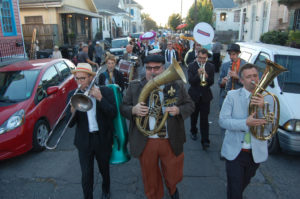 The tradition of a Second Line is generally thought to have come from New Orleans.
The tradition of a Second Line is generally thought to have come from New Orleans.
Social clubs would organize parades for Mardi Gras or for other occasions and non-members, or just passersby, would follow the musicians along their route. They would create a secondary procession, waving parasols or dancing with handkerchiefs.
In the Crescent City, second lines often formed for jazz funerals, for weddings or business openings – for a range of events where a band might be hired.
A second line feels delightfully democratic and life-affirming. You don’t have to be a musician, a war hero or beauty queen to be in the parade.
I ignored the weather forecast for Saturday and made it downtown in time to see a Second Line make its way across the great lawn of Millennium Park. This was a first act, of sorts, for a wonderful evening of programming, part of the Chicago Jazz Festival.
Giving a nod to N’awlins, the handful of brass musicians were followed by locals wearing purple and gold beads (some over their Cubbie blue tee-shirts). I didn’t join the parade, but I stood up for the entire 15-minutes procession.
I really needed it. Needed to feel part of it.
Not to Disney-ize the second line experience as a chorus of the Circle of Life from The Lion King, but it served as an unexpected focal point for a few days spent wallowing in a sense of shared mourning.
Over the two previous days, I watched a lot of TV coverage of Aretha Franklin’s funeral service, and various John McCain memorials. I was touched by how people came together for these events.
There were celebrity speakers who told personal stories of humor and humility, stories that most of us didn’t know about the iconic singer and war hero turned statesman.
There were not very veiled political comments about POTUS. He once inaccurately boasted that the diva “worked” for him simply because she performed at a casino he owned. In opposition to his divisive rhetoric, politicians from both parties, at his memorial invoked a McCain-esque refrain, “We can do better.”
But the words and tributes did not end with the friends and families, with other musicians or the DC elite, with the official mourners.
Over 15,000 came to see McCain’s casket in Phoenix before it was transported to the east coast. Thousands of everyday people made pilgrimages to Detroit, to the Wright Museum of African American History to pay R-E-S-P-E-C-T to the Queen of Soul.
The lives of these two touched so many people.
And I found myself making conversation with my friends about remarks made in the course of different tributes and about how they championed causes, whether civil rights or campaign finance reform, that I cared about.
In the last couple days, I have been thinking about how individuals can make a difference.
I have been thinking about the best attributes of people I admire; how, like second lines, these types of discussions can give birth to new marches.
Sharing celebration or grief is natural.
We can take comfort in knowing that someone else feels a similar sense of loss. We seek to amplify our joy through the company of those we can smile with.
Knowing that we had each other when we said good-bye to the Queen of Soul and a great spokesman for civil discourse and debate is no small thing.


Leave a comment